Installing a septic tank in winter: step-by-step instructions and analysis of possible errors
Construction work is carried out at any time of the year, despite the cold or heat.It is not always possible to choose a season that is comfortable for work, since the deadline for the completion of the project is running out.
In general, installing a septic tank in winter is carried out in the same sequence as at any other time of the year, however, there are a number of features that should be taken into account during installation. Knowing the basic rules for installing and connecting a treatment plant will help you avoid a number of mistakes and prevent breakdowns of expensive equipment, don’t you agree?
The article outlines the pros and cons of performing installation work in the cold season, and lists common mistakes made by inexperienced craftsmen. Step-by-step installation instructions are also described and recommendations are given for preserving the septic tank for the winter.
The content of the article:
Installing a septic tank in winter - pros and cons
Some people mistakenly assume that it is impossible to install a septic tank in winter and wait until spring to begin installation. However, this is not the case. You can install a septic tank on your property at any time of the year; moreover, in some situations, installation can only be done in winter. This happens when the groundwater level is high.
In the spring, during massive snow melting, the groundwater level rises to critical levels. A situation may arise when a newly dug pit fills with water at high speed. And then there can be no question of editing.
So it’s better to suffer a little with the top frozen layer of soil - it usually does not exceed 100 cm.
There are a number of other advantages that make you choose this time of year for installation:
- low workload of builders;
- low prices for materials;
- lack of vegetation on the site.
It's no secret that winter is a “dead” season for builders. Demand for services falls and prices have to be reduced to attract customers. You can take advantage of this and save a little. Costs for renting construction equipment and workers' services can be reduced by 10-20%.
Demand in construction stores and wastewater treatment plant manufacturers is decreasing. There are often lucrative promotional offers and other bonuses.
Installation of a septic tank requires digging a large pit and, accordingly, excavating a large volume of soil. This requires free territory, and if your site is landscaped, a lawn, flower bed or vegetable garden is planted, the installation process will negate all your efforts.
Another thing is installing a septic tank in the cold season, when there is no vegetation.
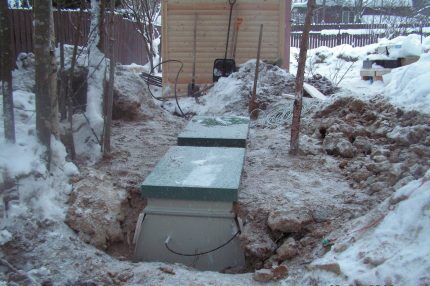
How to avoid common mistakes
When installing a septic tank in winter, mistakes are made that can subsequently cause a breakdown or poor performance of the septic tank. In winter, the daylight hours are short, the conditions outside are not the most favorable for work, and I want to finish the installation as quickly as possible. Such haste often increases the number of errors and mistakes during installation.
The most common mistakes workers make when installing a septic tank in winter:
- lack of fastening of the plastic container;
- failure to comply with backfill rules;
- lack of ventilation;
- improper placement of the septic tank;
- lack of insulation.
To avoid possible troubles, it is better to prepare in advance and take into account all the nuances.
Mistake #1: location without taking into account SES requirements
The placement of a septic tank should be determined not only by the desire of the owner of the site, but also by sanitary standards that clearly regulate the procedure for installing such structures on the site.
In particular, the sanitary area around the installation site is limited. Its radius is 15 m. It is unacceptable to locate water intake points in the sanitary zone; 50 m must be measured to a well or borehole.
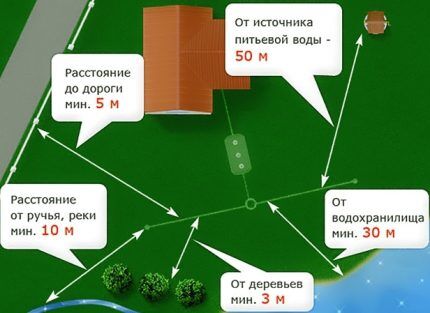
In this case, residential buildings should be located no closer than 5 m from the septic tank. The distance to the road and the border of the site is also limited - at least 2 m.
Regarding natural reservoirs, SNiP also makes its own adjustments:
- from 30 m - to reservoirs with standing water;
- from 10 m - to flowing reservoirs.
It is also undesirable to install a treatment structure in a lowland. In winter this will not be noticeable, but as the weather warms up, melt water will flood the pit and the septic tank itself, preventing its operation.
Mistake #2: Lack of anchoring
If we are talking about plastic septic tanks, which are available in a wide range on the market, you need to understand that the container will not be 100% filled with wastewater. In any case, part will be empty, which means it will be filled with air.
When the groundwater level is high, a plastic container, 20-30% filled with air, will float like a float.
At the time of installation (in winter), the groundwater level will be minimal, but you need to be prepared for the fact that in a couple of months spring will come, there will be a thaw, and there will be a significant increase in the groundwater level. And this is where the fun begins.
Water will gradually fill the pit with the septic tank, and it, in turn, will begin to float. Yes, it will not escape from the pit, but even a minimal change in position by 5-10 cm in any direction will almost certainly result in depressurization of joints, disruption of the connection with the sewer pipe, ventilation, etc.
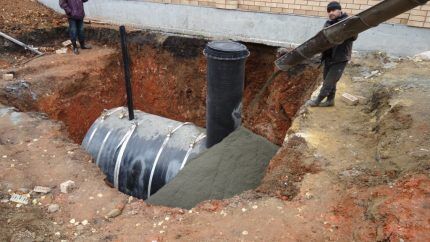
To prevent this from happening, experienced installers advise “anchoring” the container using a concrete slab installed at the bottom of the pit. An alternative option for installation in winter is to drill wells and fill them with concrete. After that, anchor bolts are placed into the body of the resulting rods, and a plastic septic tank is attached to them.
Mistake #3: Backfilling with regular soil
In winter, the top layer of soil freezes. The depth of freezing (FD) can vary significantly depending on the region. Usually this figure is close to 1-1.5 m. In order not to bury the septic tank completely below the GP, it is customary to fill the pit not with ordinary soil, but with sand or a sand-cement mixture.
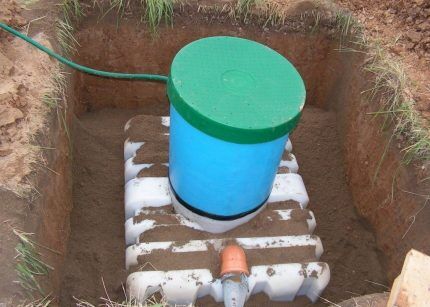
However, sometimes when filling a septic tank they make a common mistake - they do not sift the sand. It would seem that there is nothing wrong with this.
However, even a small fragment of crushed stone that accidentally ends up pressed closely against the wall of a plastic container, under the weight of a meter-long layer of soil, creates quite strong concentrated point stresses in the plastic.The result is a crack or hole in the housing.
The septic tank will be depressurized. And if suddenly the plastic doesn’t hold up and the crack goes further, the entire structure may break. In this case, repairs will no longer help; all that remains is to completely change the equipment and install it, looking back at the bad experience.
Mistake #4: lack of ventilation
In winter, installation is often limited to constructing a pit, installing the septic tank structure itself, and connecting communications. But ventilation is often forgotten.
This omission can cause excessive gas formation and, as a result, the appearance of unpleasant odors around the treatment plant or, even worse, sewer smell in the toilet or bathroom.
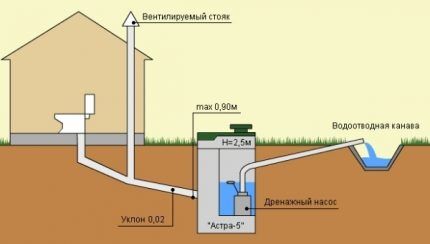
The ventilation outlet going from the septic tank to the roof of the house is called fan pipe. It serves to ventilate the container, since bacteria need air to work. If installed correctly, you will not be afraid of the aromas of hydrogen sulfide and methane.
According to the project, the vent riser is connected to the filter well or directly to the outermost compartment of the septic tank.
Mistake #5: lack of high-quality thermal insulation
When installing a septic tank in winter, insulation is forgotten much less often than at other times of the year. This is facilitated by negative air temperatures. It is recommended to insulate a septic tank in cases where it is not completely below the soil freezing depth in order to protect the structure from freezing and damage.
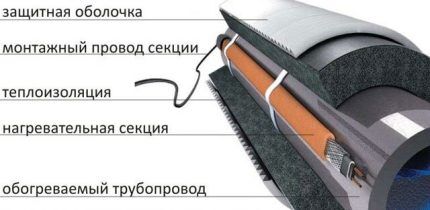
It is especially important to insulate the sewerage system in a country house if it will not be used for a long time in the winter - for example, in a country house. The body of the septic tank can be “wrapped” expanded polystyrene boards or roll insulation.
Use heating cable for pipes, which will prevent freezing of the liquid in the system. Foam chips or expanded clay are used as insulation.
Step-by-step instructions for installing a septic tank in winter
The installation process in winter is carried out in a certain order.
Regardless of the type of septic tank, the basic steps are standard:
- pit construction;
- installation of container;
- pipe laying;
- installation of additional equipment;
- insulation;
- backfilling.
Each stage is worth considering in detail.
Step 1. Construction of a pit - size and digging method
The dimensions of the pit depend on the selected septic tank. If this concrete ring structure, its height will be 3 m, and the foundation pit needs to be deeper. Finished plastic containers may differ in height and configuration.
There are tall ones - vertically oriented, but there are also horizontal ones. For them, the pit will be less deep, but larger in area.
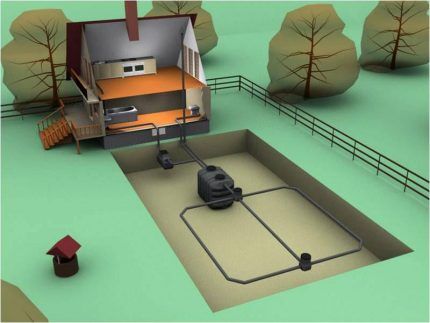
When you have decided on the location and size, you need to choose a method for digging a pit:
- independently by hand;
- with the help of a construction team;
- using technology.
Since it is very difficult to dig frozen ground in winter, the first option - by hand - is practically excluded.Even if you decide to dig a three-meter hole, armed with only one shovel, it will take a significant amount of time. Therefore, this method cannot be called rational when it comes to winter.
With the help of construction workers, the pit will be dug many times faster. They have all the necessary tools, strength, health and motivation to finish the job as quickly as possible.
By contacting qualified specialists, you will receive not only the required pit size, but also advice and practical recommendations, since builders, most likely, are faced with installing a septic tank not for the first time and have some experience.
The fastest and least labor-intensive method is to call an excavator. In this case, the excavation process will take a few hours. A powerful machine is not afraid of frozen soil, but sometimes it has to be broken with a jackhammer.
In terms of price, renting an excavator will be even cheaper than a construction crew, but not every site can accommodate such large equipment, and it still needs room to maneuver.
Step 2. Installation of a septic tank - installation process of different types
If you plan to install a septic tank made of concrete rings in winter, you need to prepare a concrete pad at the bottom of the pit for installation. Use ready-made concrete rings with special locks on the edge - this way wells made of several elements will be more stable and airtight. For installation you will have to rent a crane.
The rings are fastened together with cement mortar or liquid glass. Often the structure is strengthened by installing additional ties made of metal plates. All seams are carefully sealed with mortar or special water-repellent mixtures outside and inside.
In this case, you need to pay maximum attention septic tank waterproofing, since if a gap is formed, toxic untreated wastewater will leak into the soil.
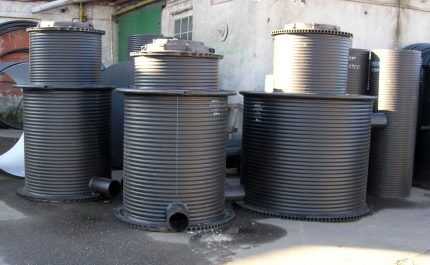
Installing a plastic septic tank in winter is easier, because you don’t have to worry about the tightness of the structure itself. However, another concern arises - consolidation.
And here you will also need a truck crane, this time for installing a reinforced concrete slab on the bottom of the pit. The container is secured to the slab using metal hinges or anchors.
Step 3. Laying communications, ventilation, drainage
Sewer pipes are laid in trenches that connect the pit to the house. Digging trenches in winter is another serious stage of earthworks. The width of the trench will be several times larger than the diameter of the pipe. For the main line, 110 mm plastic pipes are usually used.
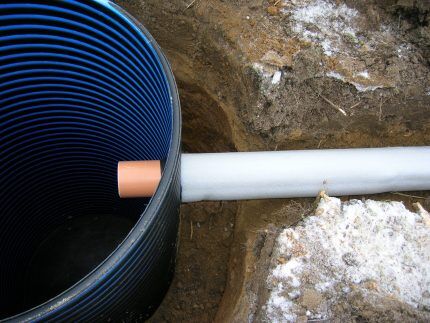
In any case, it is recommended to lay communications below the ground freezing level. Already at a depth of 2 m in most regions, the temperature in winter does not fall below +5°C. At this temperature, the water in the sewer will not freeze.
In addition, the wastewater is usually quite warm, so when the septic tank is regularly used in winter, natural heating and thawing occurs.
Calculate separately filter fields, if they are included in the project.This is a pipeline coming from the septic tank and distributing purified water throughout the field. The pipes are perforated and laid on a layer of sand and gravel. Effluent purified in the septic tank up to 60-70% enters the filtration field, where it is purified up to 98%, passing through sand.
Drainage pipes for such a system are laid below the freezing depth of the soil in winter. For ventilation, a 90° corner is placed at the end of each drain and the ventilation pipe is brought out to a height of about 1 m above the ground.
Step 4. An important step - external thermal insulation
To insulate the septic tank, fill it with silt and cover it with a layer of material with a low thermal conductivity coefficient, such as polystyrene foam, expanded clay or penoplex. The height of the insulation layer depends on the depth of freezing and the location of the septic tank in the ground.
If the plastic will be in contact with the frozen ground only at the top, the thermal insulation is designed accordingly.

But it is recommended to insulate pipes with rolled materials, for example, mineral wool. Mineral wool absorbs moisture very well, which is a significant drawback when it comes to winter insulation.
To prevent such surprises from happening, it is important to take a responsible approach to pipe waterproofing. Use sealants for sewer networks and film materials - they are convenient for wrapping pipes.
How to preserve a septic tank for the winter
If a septic tank is installed in winter, but no one plans to use it yet, the system needs to be mothballed. It is important not to leave the structure without water for a long time.
A number of recommendations on how to preserve a septic tank for the winter so that it does not freeze or break will help you do everything correctly and avoid mistakes:
- Disconnect and dismantle electrical equipment: pump, chopper, etc.
- Fill the septic tank at least 70% with water. If there is less water, the structure may float; if there is more, it may crack due to the expansion of frozen water.
- Place a container of sand in each chamber. Plastic bottles on a string will do. Fill them with sand, but so that the bottle retains its buoyancy. This simple technique will reduce the load on the body.
- Close the lid tightly and replace the insulation.
If the above cannot protect the water inside the septic tank from freezing, it can prevent equipment failure or deformation of the body.
If your wastewater treatment plant is frozen, don't panic.
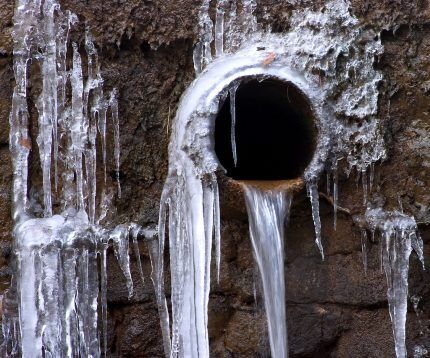
Hot water or saline solution will help melt iced pipes. In this way, you can easily and cost-effectively restore your septic tank in winter and continue to use it.
More details about preserving a septic tank for the winter and the rules for maintaining a treatment plant in the cold season are written in the articles:
- How to preserve a septic tank for the winter: step-by-step instructions
- Rules for maintaining a septic tank in winter: cleaning measures and preventive maintenance
Conclusions and useful video on the topic
Videos with visual information will help you understand how to install a septic tank in the winter, as well as how to preserve it until spring.
Installation of a plastic septic tank in winter - instructions and recommendations from a specialist:
Installation and connection of the popular model of ready-made septic tanks “Topas” in winter:
If there is a need to preserve the septic tank until the next season, this video shows in detail how to do this.
As you can see, you shouldn’t be afraid to install a septic tank in winter. This is a normal working situation and experienced builders encounter it regularly. Now you know how to avoid most installation mistakes, as well as the installation process from “A” to “Z” step by step.
Share with readers your experience of installing a wastewater treatment plant during the cold season. Please leave comments on the article, participate in discussions and ask questions that interest you. The feedback form is located below.




I would like to ask this question: what models of septic tanks are strictly not recommended for installation in winter? Or can you use any? I’m also interested in whether a material such as wood sawdust (or shavings) is suitable for insulating a septic tank. I just, in my opinion, read somewhere that they are also perfect for this task. But I'm interested in the specialist's answer.
In winter they install any septic tank, there are no restrictions here. The only thing is that plastic exhibits cold brittleness in the cold, so you need to work with it carefully. And in the spring you will need to add soil if it fails.
But I don’t recommend insulating with sawdust - they will get wet, freeze and lose their thermal insulation properties. For budget insulation, it is better to use expanded clay.
Yes, this is all clear, even windows are cheaper to install in winter.Since no one is overloaded with work, there is a possibility that they will do a better job in terms of installation, but here is a septic tank. But I still tried to get everything done for me in the summer. I planned in advance, hired a crew, waited about 2 months, so I made an agreement in the spring. The neighbors did it in the winter, I didn’t like how they installed it. As for insulation, I would better advise taking polystyrene foam.
I installed it in winter, although we don’t have severe frosts. Everything went fine. There was a problem with opening the top frozen layer, but then it was just a song - nothing collapsed, everything was dry. I can imagine how much dirt they would spread in the spring.
When installing a biological station in winter: is it necessary to spill sand around the station?